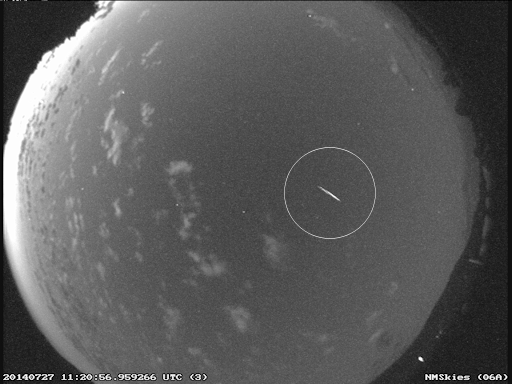The Perseids are my favorite meteor shower for much the same reasons that it’s everyone’s favorite meteor shower: it’s a good, active shower and it happens when it’s WARM outside. I am far too much of a wuss to spend many cold, lonely hours outside in the early morning for the Leonids unless it’s predicted to be really good, but I’ll stay up for the Perseids on the off chance that it’ll put on a good show. (After I coat myself in many layers of bug repellant, that is.)
This year’s Perseids are already warming up with a few fireballs spotted by NASA all-sky cams in New Mexico and elsewhere this past weekend. The peak of the shower isn’t until August 11-13, but that happens to come just after the (say it with me now) SUPERMOON. Okay, the “supermoon” isn’t all THAT super, just a full Moon that’s at the closest point in its orbit. Your eye can hardly tell the difference. But a nearly full Moon does wash out the sky, making it hard to see fainter meteors. That reduces how many you can see, making the peak less spectacular.
But that doesn’t mean you can’t enjoy the Perseids right now and through the beginning of August. After all, the Perseids are the “Fireball Champion” of meteor showers, producing more and brighter fireballs than any other shower from the debris of Comet Swift-Tuttle. David Dickinson of Universe Today has more tips for observing this year’s shower.
Indoors or clouded out? You can hear the effects of meteors with a simple AM/FM radio. (Yes, I checked, they still make them.) The meteor leaves a trail of ionization (charged particles) behind it that can temporarily boost the signal from a distant FM station on your radio dial. Or, you can hear results from some more powerful equipment with Space Weather Radio. But try the activity if you can. Just like it’s a special treat to see the photons from a distant object hit your eye through a telescope, it’s a special kind of feeling to pick them up yourself with radio equipment you may already have at home.
Are there ways to support citizen science with meteor showers? Of course! The meteor counter app for Android or iOS makes meteor counting easy, just as long as you don’t blind yourself or your friends with that bright smartphone screen. You can also report fireballs to the American Meteor Society any time of year using their website, iOS app, or Android app. Getting accurate positions from multiple observers is particularly helpful for triangulating where a fireball came from in the sky.
Happy meteor hunting!
With thanks to SciStarter for making it easy to find meteor-related citizen science apps!





 Join the Crew!
Join the Crew!
 Escape Velocity Space News
Escape Velocity Space News
0 Comments